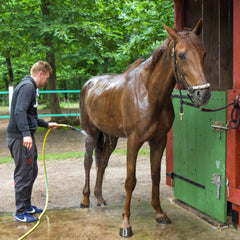The Overheating of Horses - Recognize and Prevent
As much as the heat bothers us, animals suffer even more. We've come up with tips and tricks for you to weather the heat well with your horses.
I. Steppe-animal Horse - Bye, bye heat?
The rumor persists that horses are optimally adapted to hot, dry climatic conditions due to their evolutionary past as steppe animals. Of course, some races lived and still live in dry and hot areas - but they are adapted to the weather and should not be compared to horses from our latitudes. This also goes for horses that are native to the northern regions. Generalizations are absolutely superfluous when it comes to the question of heat protection. Primarily, horses do not handle heat as well as we do. It follows that the heat perception of the rider should not be decisive for the training of the horse. Looking at the physiological structure of the body explains why: Horses have a significantly higher proportion of active muscles, which can increase the inner body temperature enormously - even during small amounts of work. Even though horses can cool off well due to their large evaporation surface, in relation to their sweat production this surface is quite small. The current temperatures of approx. 32 degrees can lead easily to 20 - 30 liters of sweat during physical work. If the outside temperature is very high and humid, the cooling effect is eliminated and the horse overheats. Already 15 minutes of work can raise the horse's body to unhealthy temperatures.
II. Age, coat color, race - who can tolerate it better?
Not only the habituation plays an important role in the tolerance to hot weather. Factors such as age, race or coat/fur contribute to the perception of heat. Under direct sunlight, a horse with a small crest tends to sunstroke faster than a horse with a tall crest, due to the direct exposure of the sun on their sensitive foreheads. The color of the coat also plays a decisive role: Black attracts the sun - a saying that is well known to everyone. Horses with dark or even black fur are therefore particularly sensitive to direct sunlight. The same applies to the thickness of the coat. Especially older or sick animals have problems with the change of coat and can not completely switch to the thin summer coat. Additionally, imported horses from abroad - for example from Iceland or England - do not tolerate the heat very well because their organism is adjusted to different weather conditions.


III. Detecting heat strokes and counteract
Overheating of horses should never be taken lightly. The horse can retain permanent damage or even die as a result. Especially horses that are not adapted to the weather can quickly reach temperatures of up to 41 degrees - the muscle temperature can then reach 43 degrees, which means that the proteins begin to disintegrate. If overheating persists and is not acted upon quick enough, organ failure and circulatory collapse can be the result. Physical work is not the only cause for overheating. Shadowless fields and not enough water are also sources for a heat-stroke. The response time is most crucial in such situations to avoid serious damage - however, first the overheating must be recognized:
- The horse has at rest already a significantly increased respiratory rate
- Nostrils are very enlarged and the mouth can be open
- The horse looks apathetic and shaky
- Body temperature rises sharply (over 39 degrees)
- The horse suffers sweats
- Resting or circulatory collapse
If the horse is already overheated, it needs quick and professional help - calling a veterinarian is essential to prevent further damage. The most important thing is to keep the horse out of the sun and to hang wet, cool towels or blankets over his back and neck. Water should never be served ice-cold, but always tempered. If the horse is already lying on the ground due to circulatory collapse, neither water nor food should be given - the swallowing reflex may already be impaired. The additional waving of fresh air may favor a fall of the body temperature.


IV. Prevent better
In order to avoid significant damage concerning overheating, the correct prophylaxis needs to be utilized:
- Provide a sufficient water supply (during hot temperatures, a horse drinks up to 50 liters)
- If possible, keep your horse out of the midday sun - bring them into the stable
- Leave horses outside overnight and keep them inside the barn during the day (only if the barn is actually cooler)
- Provide sufficient shade on the fields
- Shower off horses with tempered water (start at the rear legs)
- Provide adequate electrolyte balance - mineral feed or salt lick stone
- Only transport in emergencies
- Riding early in the morning or late at night - adjusting the units to the weather







